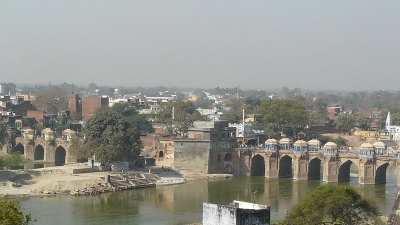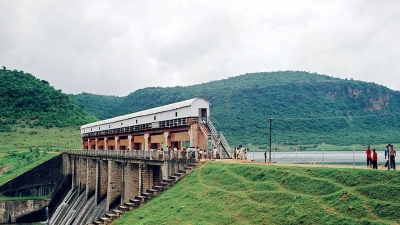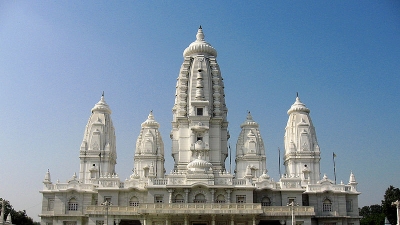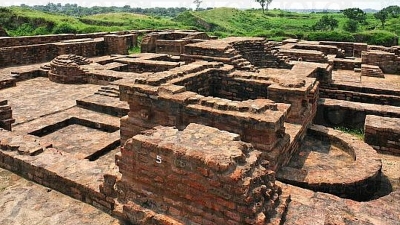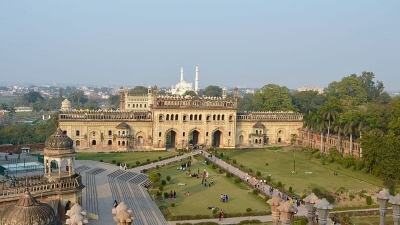Allahabad Attractions - Tourist Places To Visit In Allahabad
-
01Sangam
+ Read MoreSangam, which is the Sanskrit word for “confluence” is quite literally a confluence of three holy rivers in India. The “Triveni Sangam” as the official name goes is the meeting point of the Ganges, Yamuna and the mythical Saraswati rivers in Allahabad. It is believed that the Saraswati river disappears underground at the meeting point.
This scenic location is considered to be very holy by Hindus and priests. Hindus believe that a dip at this confluence can wash away all of one’s sins and free him from the cycle of rebirth. This site is famous for hosting the kumbh mela once every 12 years. The ardh kumbh is also held here after every six years.
An annual Magh Mela is also held here in the month of January. Devotees, notwithstanding the cold, take a purifying dip in the sangam.The ashes of several national leaders and personalities have been immersed here, including the ashes of Mahatma Gandhi in 1948.
-
02Patalpuri Temple
 + Read More
+ Read MoreThe Patalpuri Temple is one of the oldest temples in India, dating back to the Vedic period. This beautifully carved underground temple is built within the Allahabad fort close to the immortal banyan tree, Akshaya Vat.
The fort is occupied by the Indian army and the entire garrison is not open to public. However, the eastern gate is open to civilians. It is through this gate that visitors can visit the beautiful 16th century underground temple which houses beautiful idols of various Hindu Gods and Goddesses.
The temple is located close to the Sangam, a holy spot for Hindus. Hindu mythology has it that Lord Rama visited this place. The temple also finds mention in the records of Chinese pilgrim Huan Tsang who visited India during the reign of emperor Harsha in the 5th century.
-
03Allahabad Fort
+ Read MoreThe Allahabad Fort was the largest fort built by Akbar. Built in 1583, it was considered to be one of the best forts of its time. The fort stands at the confluence of the Yamuna and Ganga rivers in Allahabad. It is well known for its unique design, construction and craftsmanship.
The fort is now occupied by the Indian army. While entry to most parts of the fort is restricted, some parts are, however, open to civilians. It is said that the fort is the location of the Akshayavat or immortal tree.
However, the tree is in the restricted part of the fort and is not accessible to visitors as such but can be visited after special permission from the officials. The fort also houses the gigantic 10.6 m high, polished sandstone Ashoka Pillar, which is believed to have been constructed in 232 BC. The pillar is of great importance to the historians and archaeologists.
-
04Allahabad University
+ Read MoreThe University of Allahabad, also known as the Allahabad University is one of the oldest English language universities in India. During the British rule, the Lt. Governor of the Northern Provinces, Sir William Muir initiated the idea of a central educational institution.
He built the Muir Central College which eventually evolved into the Allahabad University over the years. Initially the university functioned under the University of Calcutta. However, in 1887, it was recognized as an independent university, and became the fourth modern university established in India.
The university was built by noted British architect William Emerson who also has the Victoria Memorial in Kolkata to his credit. The institution represents Indo-Saracenic Egyptian and Gothic structure.
-
05Akshayavat
 + Read More
+ Read MoreAkshayavat, also known as the “indestructible Banyan tree”, is a holy tree located near the Patalpuri temple at the Allahabad fort. According to a famous legend, when a sage asked Lord Narayana to show him divine power, the Lord flooded the world just for an instant and then made the water disappear again.
However, during the floods while everything else drowned, only the top of the ‘Akshayavat” could be seen. The banyan tree is therefore considered to be an immortal tree. The fort is today occupied by the Indian army. However, people can visit the temple and the tree after seeking permission from the army centre there. During the Kumbh Mela though, the site is open to all pilgrims.
-
06Anand Bhawan
 + Read More
+ Read MoreAnand Bhavan, which literally translates into ‘”abode of happiness”, served as the ancestral home of the Nehru-Gandhi family. Swaraj Bhawan is the new name accorded to Anand Bhawan.
Motilal Nehru, one of India’s noted 19th century politicians, and father of Jawahar Lal Nehru, the first prime minister of independent India, bought this house when it was in shambles. He refurbished the entire estate over the years and bought specially crafted European furniture from China to give it an English look.
Over the years, the house became the meeting point of great minds and political leaders and was practically the headquarter during the Indian Independence movement. Today, the house lies vacant but is maintained by the Jawaharlal Nehru Memorial Fund. Tourists regularly visit the house to take a step back in time.
-
07Khusro Bagh
+ Read MoreThe Khusro Bagh is a well protected walled garden close to the Allahabad junction station. It surrounds the three tombs of the Mughal king - Jehangir’s family. The three tombs belong to Khusrau Mirza (Jehangir’s eldest son), Shah Begum (Jehangir’s first wife) and Princess Sultan Nithar Begam (Jehangir’s daughter).
They were buried within this complex in the 17th century. The beautifully carved three-tier tombs exemplify the best of Mughal art and architecture. It is said that Jehangir employed the country’s best artisans to build these tombs.
Jehangir’s eldest son was murdered by his brother Shah Jahan. It is believed his mother poisoned herself and died an unnatural death. However, the emperor spared no expense on the tombs. The garden itself is famous for mango and guava trees.
-
08Hanuman Temple
 + Read More
+ Read MoreConsidered to be one of Allahabad’s most important temples, the Hanuman Temple is a favoured religious destination among Hindus. It was built in 1787 and houses a 20 ft idol fo Hanuman in reclining a position.
Other prominent Hindu Gods are also enshrined in the temple. Over the years, the temple underwent several renovations, the last which took place in the 1940’s. The temple is centrally located and is close to the main railway station.
It is open throughout the year for pilgrims to offer prayers. The temple is located near Allahabad fort near the banks of the river Ganga and when the river is flooded, the temple gets submerged in the water.
-
09Allahabad Museum
+ Read MoreThe Allahabad Museum was built in 1931 and is funded by the Ministry of Culture. The museum enjoys the reputation of being one of the finest in terms of the unique objects of art which it houses. The museum is located near another of the city’s attraction - the Chandra Shekar Azab park.
Inaugurated in 1947, the year India became independent, the museum has 18 separate galleries dedicated to archaeological findings, natural history exhibits, art gallery and terracotta artefacts. It also has on display some of the documents and personal items of Jawaharlal Nehru and memorabilia related to Indian freedom movement.
The museum also displays antiques and works of arts from renowned schools of sculpture such as Gandhara, Mathura, Kausambi and Saranath. Another highlight is the coin collection from ancient India including gold coins from Kushana and Gupta periods.
-
10Allahabad High Court
 + Read More
+ Read MoreThe Allahabad High Court was one of the first high courts to be established in India. It has complete jurisdiction over the state of Uttar Pradesh. During the British Rule, this High court was first established in Agra and then later shifted to Allahabad due to reasons of administration.
The present building was made in the 1950s. The court is a massive complex built Indian-British architecture style. The well-kept lawns and fields in front of the High Court date to the British Raj and add to the natural beauty of the vast complex.
-
11All Saints Cathedral
+ Read MoreThe All Saints Cathedral, a famous church located at the crossing of two primary roads in Allahabad, is an exquisite gothic style building built by the British in the 19th century. A famous British architect – William Emerson who also designed the famous Victoria Memorial in Kolkata.
This elaborate structure can accommodate around 400 people at a time. The wide stairways and gothic style Victorian carvings reflect a style of architecture that flourished during the late medieval period. The church celebrates its anniversary on All Saints Day (1st Nov) of every year. Special prayers and festivities are arranged for the event. The cathedral is also known as ‘Patthar girja’ or the stone church.
-
12Alfred Park
+ Read MoreThe Alfred Park is the largest park in Allahabad. It is the only park that is spread over an area of 133 acres. It was built to mark Prince Alfred’s visit to Allahabad during the British rule. Huge statues of King George - V and Queen Victoria were also installed within the park.
The park has an imposing white marble canopy dedicated to Queen Victoria. The canopy represents typical British style of architecture as it flourished during that period. This neatly laid out park lies peacefully in a corner of the bustling city and is a site worth visiting.
This colonial era landmark attracts a fair share of visitors and especially those who desire some moments of peace away from the hustle and bustle of the city. The park was later renamed Chander Shekhar Azad Park after a great Indian freedom fighter.
-
13Bade Hanumanji Temple
 + Read More
+ Read MoreThe Bade Hanumanji Temple located in Allahabad is a simplistic Hindu temple dedicated to Lord Hanumanji. The locals believe that the idol at the temple has great powers. As per a popular legend, a rich trader had the statue built and he took it with him on a pilgrimage across the northern sub-continent.
During the journey, Hanumanji came in his dreams and asked him to leave the statue at that particular spot. The trader did as he was told and years later, Balagiri found the statue and built the present temple. It is said that after the trader left the statue at the dedicated place, all his wishes were fulfilled. It is little wonder that the temple attracts hordes of devotees who visit the temple with the same hope.
-
14Lalita Devi Temple
 + Read More
+ Read MoreThe Lalita Devi Temple is one of the two Shaktipeeths present in Allahabad. Legend has it that Bhagwati Lalita Devi appeared here after the fingers of Sati fell near the Yamuna. Over the years, the temple has been renovated several times. The last time when it was renovated was in the year 1987.
The 103 ft high temple has a 41 ft entrance. Although it attracts devotees the year round, the number of visitors are very high during the Navratri period when all nine forms of goddesses are decorated differently.
-
15Thornhill Mayne Memorial
 + Read More
+ Read MoreThe Thornhill Mayne Memorial is reminiscent of the British period in India. It was built to house the legislative assembly during that era. The building is a white sandstone structure with elaborate gothic style carvings and designs. It has now been converted into a public library for the locals. Apart from the students it is also frequented by historians.



 Click it and Unblock the Notifications
Click it and Unblock the Notifications







